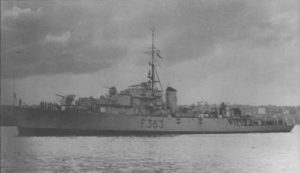- Author
- Thomson, Max
- Subjects
- Ship histories and stories, WWII operations
- Tags
-
- RAN Ships
- HMAS Katoomba, HMAS Gympie, HMAS Gladstone I, HMAS Hawkesbury I
- Publication
- March 1998 edition of the Naval Historical Review (all rights reserved)
For an RAN ship, Palawan on the edge of the South China Sea was a unique place indeed to visit; especially amid circumstances that were dramatic to say the least.
Amid the wreckage of war there, it stumbled across one of the Pacific’s horrendous war atrocities.
To this day, it is doubtful if any other Australian ship ever has visited Puerto Princesa, capital of Palawan, the westernmost island of the Philippines Group lying 500 miles south of French Indo China, as it used to be.

With the American destroyer-escort USS CRONIN, the frigate HMAS HAWKESBURY was detailed to leave the US fleet base at Leyte Gulf to escort the big American tender USS POKOMOKE to Puerto Princesa.
Wending its way through the islands and the Mindanao Straits, the convoy entered the Sulu Sea on the 600-mile passage to Palawan, steaming at 16 knots with the two warships zig-zagging at 17.5 knots out in front to offer a protective screen for the big supply tender with its vital cargo.
Palawan had just been captured by American forces and fighting was still taking place in the hills and jungle behind Puerto Princesa. From the bridge of HMAS HAWKESBURY, using telescopes and binoculars, crewmen were able to see American and Japanese artillery units in duels in the hills sloping down to the bay. Aircraft overhead observed the fall of shot and each flash of flame from artillery guns was followed by an exchange from the Japanese positions.
Strewn around the harbour were sunken Japanese vessels and on the airstrip was scattered the remains of aircraft smashed by bombing and naval bombardment.
Tapestries and religious ornamentation were lying in ruins inside the shell of what had been a most picturesque Spanish-style church at the corner of one of the main streets. Forms, papers and documentation were strewn about as a result of heavy damage to the town’s administration building.
But what captured the attention of the HMAS HAWKESBURY men was a large corrugated iron building. On its roof, though not easy to read because of damage, were the words “AMERICAN PRISONER OF WAR CAMP”.
The Australians were quick to learn of the fate that had befallen 150 Americans held prisoner there but it wasn’t until well after the war that the men of HMAS HAWKESBURY were to learn the full implications.
Edwin P. Hoyt in his remarkable book “JAPAN’S WAR” recorded something of the atrocities that had occurred in the Philippines and of the Puerto Princesa episode he wrote:
“One of the worst was on Palawan Island where 151 American prisoners of war had been slaving to build an airfield for the Japanese. When an American aircraft appeared overhead, the garrison commander ordered all the prisoners into their air raid shelters. He then ordered his troops to pour petrol over the shelters and to ignite them. Most of the trapped Americans were burned to death. Those who escaped were machine-gunned. Ultimately, only nine men survived by jumping into the sea and swimming to another island where they eluded the Japanese.”
There was only one variation in that account so far as the men of HMAS HAWKESBURY were concerned. For, at Puerto Princesa, they had been told the atrocity occurred not when a US aircraft appeared but when the Japanese had sighted offshore a sizeable force which they believed was about to attack Puerto Princesa but which, at that stage, headed a shade further north to attack Mindoro first.
HMAS HAWKESBURY had an association with the prisoner-of-war scene that was probably quite unique for any WW II RAN warship.
Initially, it had that insight into what had happened to the American prisoners-of-war at Puerto Princesa. Then, at the war’s end, HMAS HAWKESBURY was the only RAN warship rushed to Singapore where it hosted Changi prisoners aboard every day and night before making two trips back escorting transports that repatriated the 8th Div. AIF men and civilian internees home to Australia.
Racing to Koepang in Timor, HMA ships HAWKESBURY, GYMPIE, KATOOMBA, GLADSTONE and MORESBY provided the naval ceremonial touches when Brigadier Dyke accepted the formal surrender of the 48th Japanese Division led by Lt.-Gen. Yamada.




